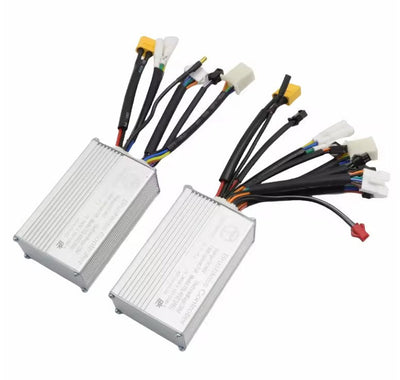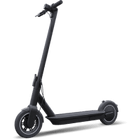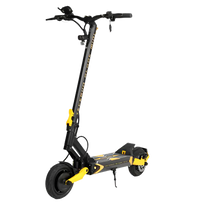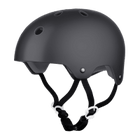What to Do When Your E-Scooter Won't Turn On

Waking up one morning to discover that your e-scooter won't turn on can be frustrating. You've come to rely on it for those quick, easy commutes around town, and suddenly, you're left stranded. Don't worry, as this is a common issue that many e-scooter users face. Tackling the problem early ensures your electric scooter will be ready to go when you need it most, helping maintain the flow of daily routines without a hitch.
Ensuring your e-scooter is always in working order doesn't have to be complex. It's about knowing where to look and what simple steps to take. In this guide, we'll explore some common reasons why an e-scooter might not turn on and how you can address these issues. From checking batteries to examining wiring, there's a straightforward approach to getting back on the road.
Check the Battery
The battery is often the first place to check when an e-scooter refuses to power up. It's like the heart of your scooter, and just like we need enough energy to function, so does your scooter.
1. First, look at the charge level. Many e-scooters have an indicator that lets you know how much juice is left. If it's low, that's likely the culprit.
2. Make sure the battery is connected properly. Sometimes, the connection may become loose, especially if you've been on a bumpy ride. Secure connections ensure the power flows smoothly.
3. Regular charging is key. If the battery hasn't been charged for a while, it's a good idea to plug it in for a few hours. Use the charger provided with your e-scooter, as it matches the battery's specifications.
Checking these basic battery-related steps often resolves the issue. If the battery seems fine, yet there's still no power, the next step involves looking at other components.
Inspect the Power Button and Wiring
If the battery isn't the issue, another place to investigate is the power button and wiring. These elements can signal if there’s another underlying problem.
Start with the power button. Is it intact? If it looks damaged or isn't clicking into place properly, it could be preventing the scooter from turning on. Be gentle but firm when testing the button, and see if it reacts differently than usual.
Next, inspect the wiring for any visible issues. Look for wires that might be exposed or disconnected. Over time, vibrations from the ride can loosen things up, leading to electrical issues. Use a gentle touch to adjust any loose wires if you’re comfortable doing so. For wiring that looks beyond a simple fix, seek help from a professional who can secure things safely.
By taking these steps to check on the battery, power button, and wiring, you're on your way to having your e-scooter running smoothly again. In the next part, we'll look at possible software issues and the role of the fuse, keeping your rides carefree and enjoyable.
Look for Software Issues
Sometimes, the challenge isn’t physical but lies within the software. Just like when your phone becomes glitchy, your e-scooter might experience hiccups in its software too. The solution can be as simple as performing a reset, which can refresh the internal system and get your scooter working again.
To reset your e-scooter, try holding down the power button for ten to fifteen seconds. This action might clear any minor software bugs that prevent it from starting. It's a good idea to consult your user manual for any unique instructions specific to your model as the reset method could vary slightly.
If the reset trick doesn’t do it, a deeper issue might be at play. The user manual is also handy here, offering guidance on diagnosing software errors that may require professional assistance. If you’re in doubt, erring on the side of caution and seeking expert help is wise.
Examine the Fuse and Components
Fuses play a crucial role in the electrical system of your e-scooter. They are like gatekeepers, protecting sensitive components from electrical surges by breaking the current if something goes awry. If your e-scooter isn’t turning on, a blown fuse could be responsible.
To inspect the fuse, you’ll need to locate it first. This is usually found near the battery or within the main board compartment. If it looks burned out or damaged, it likely needs replacing. Handling this alone isn’t suggested unless you’re well-acquainted with electrical components. The safest bet is to let a professional handle the replacement to avoid further damage and ensure safety.
Checking other parts while you're there could prove useful. Components like the throttle, brakes, or control panels can impact performance if they’re in poor condition. Keeping them in check helps maintain the health of your e-scooter.
Keep On Riding Smoothly
By now, you’ve got a toolkit of strategies for dealing with a stubborn e-scooter that refuses to turn on. From peek-a-boos under the hood for loose wires to checking up on its electronic health, knowing your way around these checks can save you a lot of time and hassle.
Using a regular maintenance routine can help prevent these hiccups from cropping up when you least expect it. It’s a way of saying “thank you” to your scooter for all those comfortable rides it gives.
Remember, if something seems overly complicated or beyond your comfort zone, enlisting professional support isn't just okay – it's a smart move. We're there to keep your e-scooter adventures free from stress, allowing you to enjoy more rides with fewer interruptions.
For those looking to ensure smooth and uninterrupted commutes, exploring high-performance options can make all the difference. Discover the right e-scooter for your daily travel needs at Freed Electric Scooters. Our team can help you find the perfect fit to keep your rides swift and hassle-free. Enjoy the freedom of the open road with a reliable e-scooter today!





